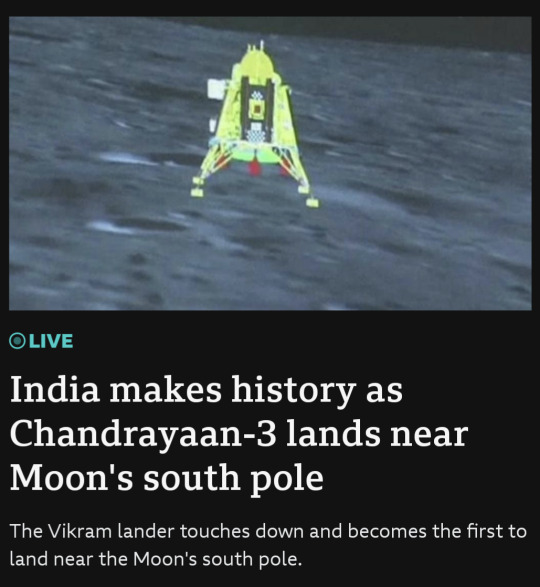#New India
Text
one of these days fucking america is going to realise that they don't get to fund the russia-ukraine war and the gaza war and slap multiple sanctions on middle eastern countries and boycott whichever little country they don't like and then call india unethical and unprincipled because they heard the name of the new internal affairs law and didn't bother to research it's context or history
2 notes
·
View notes
Text
PM Modi’s Independence Day Speech Unveils Roadmap for Developed New India
PM Modi’s Independence Day Speech Unveils Roadmap for Developed New India
Prime Minister Narendra Modi’s inspiring speech on the Amrit Mahotsav of India’s Independence unveils a glorious roadmap for a developed India by the time of the Shatabdi celebrations of our freedom. PM Modi in his passionate, extempore address to the nation has laid down the blueprint for the next twenty-five years. The aspirations of this developed India strike a perfect balance between our…
View On WordPress
#congress#day#developed#dynasty#independence#independence day#India#India at 75#Modis#Narendra Modi#New India#Partition#Roadmap#Savarkar#speech#unveils
4 notes
·
View notes
Text




#yemen#jerusalem#tel aviv#current events#palestine#free palestine#gaza#free gaza#news on gaza#palestine news#news update#war news#war on gaza#india#boycott divest sanction#direct action#bds movement
15K notes
·
View notes
Text
Ecology-Environment : नैनीताल के वन क्षेत्र में हुआ होटलों के लिये सड़क का निर्माण, एनजीटी ने किया पैनल का गठन...
नवीन समाचार, नई दिल्ली, 26 सितंबर 2023 (Ecology-Environment)। एनजीटी यानी राष्ट्रीय हरित न्यायाधिकरण ने उत्तराखंड के नैनीताल जिले में नैना देवी हिमालयन पक्षी संरक्षण अभयारण्य में नियमों का उल्लंघन कर कथित रूप से सड़क का निर्माण करने वाले निजी होटल मालिकों द्वारा पर्यावरण को पहुंचाए गए नुकसान का पता लगाने के लिए एक पैनल का गठन कर दिया है।
उल्लेखनीय है कि एनजीटी में एक याचिका कर आरोप लगाया गया है…

View On WordPress
#Articles#Dam#Developement#Development#Ecology#Impacts of Pancheshwar Dam#Impacts of Pancheshwar Dam on Proposed Tanakpur-Bageshwar Rail Line#India#Indo-Nepal#Kumaon#Kumaun#Maowadi#Maowadi Activities in Kumaon#Modern India#Nepal#New India#Pancheshwar Dam#Pithouragarh#Places#Politics#Uttarakhand#World&039;s 2nd Highest Dam
0 notes
Text
Make In India – The New Indian Scheme 2023
Narendra Modi, who within a matter of months, launched the ‘Make in India’ campaign to facilitate investment, foster innovation, enhance skill development, protect intellectual property & build best-in-class manufacturing infrastructure.
Make in India’ recognizes ‘ease of doing business’ because the most essential element to sell entrepreneurship. A range of initiatives have already been undertaken to ease the business environment. The goal is to de-license and de-modify the enterprise in the course of the whole lifecycle.
Visit the website for more information about this topic with an relatable video-
0 notes
Text
Scientists have developed a new solar-powered system to convert saltwater into fresh drinking water which they say could help reduce dangerous the risk of waterborne diseases like cholera.
Via tests in rural communities, they showed that the process is more than 20% cheaper than traditional methods and can be deployed in rural locations around the globe.
Building on existing processes that convert saline groundwater to freshwater, the researchers from King’s College London, in collaboration with MIT and the Helmholtz Institute for Renewable Energy Systems, created a new system that produced consistent levels of water using solar power, and reported it in a paper published recently in Nature Water.
It works through a process called electrodialysis which separates the salt using a set of specialized membranes that channel salt ions into a stream of brine, leaving the water fresh and drinkable. By flexibly adjusting the voltage and the rate at which salt water flowed through the system, the researchers developed a system that adjusts to variable sunshine while not compromising on the amount of fresh drinking water produced.
Using data first gathered in the village of Chelleru near Hyderabad in India, and then recreating these conditions of the village in New Mexico, the team successfully converted up to 10 cubic meters, or several bathtubs worth of fresh drinking water. This was enough for 3,000 people a day with the process continuing to run regardless of variable solar power caused by cloud coverage and rain.
[Note: Not sure what metric they're using to calculate daily water needs here. Presumably this is drinking water only.]
Dr. Wei He from the Department of Engineering at King’s College London believes the new technology could bring massive benefits to rural communities, not only increasing the supply of drinking water but also bringing health benefits.
“By offering a cheap, eco-friendly alternative that can be operated off the grid, our technology enables communities to tap into alternative water sources (such as deep aquifers or saline water) to address water scarcity and contamination in traditional water supplies,” said He.
“This technology can expand water sources available to communities beyond traditional ones and by providing water from uncontaminated saline sources, may help combat water scarcity or unexpected emergencies when conventional water supplies are disrupted, for example like the recent cholera outbreaks in Zambia.”
In the global rural population, 1.6 billion people face water scarcity, many of whom are reliant on stressed reserves of groundwater lying beneath the Earth’s surface.
However, worldwide 56% of groundwater is saline and unsuitable for consumption. This issue is particularly prevalent in India, where 60% of the land harbors undrinkable saline water. Consequently, there is a pressing need for efficient desalination methods to create fresh drinking water cheaply, and at scale.
Traditional desalination technology has relied either on costly batteries in off-grid systems or a grid system to supply the energy necessary to remove salt from the water. In developing countries’ rural areas, however, grid infrastructure can be unreliable and is largely reliant on fossil fuels...
“By removing the need for a grid system entirely and cutting reliance on battery tech by 92%, our system can provide reliable access to safe drinking water, entirely emission-free, onsite, and at a discount of roughly 22% to the people who need it compared to traditional methods,” He said.
The system also has the potential to be used outside of developing areas, particularly in agriculture where climate change is leading to unstable reserves of fresh water for irrigation.
The team plans to scale up the availability of the technology across India through collaboration with local partners. Beyond this, a team from MIT also plans to create a start-up to commercialize and fund the technology.
“While the US and UK have more stable, diversified grids than most countries, they still rely on fossil fuels. By removing fossil fuels from the equation for energy-hungry sectors like agriculture, we can help accelerate the transition to Net Zero,” He said.
-via Good News Network, April 2, 2024
#water#water scarcity#clean water#saline#desalination#off grid#battery technology#solar power#solar energy#fossil fuels#water shortage#india#hyderabad#new mexico#united states#uk#united kingdom#good news#hope#aquifers
822 notes
·
View notes
Text
so far, nearly 3 weeks on from the inauguration of ram mandir, indian authorities have demolished as many masjids and/or madrasas.
30.01.24 - akhoonji masjid & madrasa in delhi, also destroying a cemetery, shrine and all the students’ belongings in the process.
01.02.24 - a madrasa in maharashtra despite facing opposition from local muslims and one day before its scheduled court appeal.
08.02.24 - a masjid & madrasa in uttarakhand. this comes one day after uttarakhand became the first state to pass the uniform civil code (x, x) which aims to apply a ‘hindu code’ to all indians, infringing on the rights of dalits, adivasis, sikhs, christians, buddhists and muslims (i.e. anybody non-hindu) to practice their religion/lifestyle. muslim women protesting the demolition were lathi-charged (beaten with sticks) by police, a shoot-on-sight order was given resulting in 6 muslims killed and 300+ injured in the riots that followed, a curfew was put in place during which hindutva mobs burned down muslim homes and businesses while shouting abuse at muslims.
as always, no prior notice was given and bjp used it’s gold-standard excuse for each demolition, citing ‘illegal encroachment’.
in addition to these masjid demolitions, indian authorities bulldozed 2 neighbourhoods (ghettos, really) in the same timeframe and also without prior notice:
01.02.24 - jasola slum, which, having been around for at least 16 years, should not have been demolished without providing alternative housing, as the delhi slum policy states for slums which came up before 2015. obviously, housing hasn’t been provided.
06.02.24 - panchsheel nagar in mumbai which, having been around since 2011, entitled residents to paid rehabilitation, which has also not been given. this has left over 110 families homeless.
the demographic of both neighbourhoods, surprise surprise, is overwhelmingly muslim, buddhist and dalit.
bjp is enjoying the cover it is receiving from israel’s genocide in palestine to do whatever it wants and is getting bolder by the day. this ‘bulldozer justice’ has been happening for years, but not at such a rapid rate as it is now.
#and bjp’s crimes are always underreported or not reported at all in mainstream news anyway#india#m#!
1K notes
·
View notes
Text

what an amazing day to be Indian ❤️ Congratulations to the physicists, engineers, scientists and all staff involved, this is outstanding 🎉
2K notes
·
View notes
Text
Saw some old vines and got inspired:
So here y'all go, Spiderverse as Vines!
#am I late? maybe#but better late than never#getting used to use a new video editor so this was a good exercise for that#some of these might be a reach but I had fun making them so I included them anyways#okay now who to tag...#hobie brown#spider punk#miles morales#spider man#miguel o'hara#spider man 2099#gwen stacy#spider gwen#peter b parker#pavitr prabhakar#spider man india#LYLA#hope this post shows up in the tags cause usually tumblr won't let my video posts show up there for some reason#across the spider verse#atsv#spiderverse#vine#my video#my post
392 notes
·
View notes
Text
भैयाजी कहिन : सबके विश्वास से बनेगा मोदी का 'न्यू इंडिया'
भैयाजी कहिन : सबके विश्वास से बनेगा मोदी का ‘न्यू इंडिया’
न्यूज़18 इंडिया के खास पब्लिक डिबेट शो ‘भैयाजी कहिन’ में आज का मुद्दा था, सबके विश्वास से बनेगा मोदी का ‘न्यू इंडिया’. इसी मुद्दे पर लोगों से बातचीत की गई और जनप्रतिनिधियों से उनकी राय जानी गई. देखें वीडियो…
Source link
View On WordPress
0 notes
Text

"Hey~!"
#i literally cannot get enough of my boy#tried to mimic his movie style but.....i don't know??#this time the overtones are a lot less jarring#also NEW ARTSTYLE AGAIN#“Dr Shaka: Get Shocked Back Into Life!”™#pavitr prabhakar#spider man india#atsv#spiderman#spider man fanart#spider man across the spider verse#across the spiderverse#myart#artoftheagni
2K notes
·
View notes
Text

Adorable East Indian Girl!. OMG.... she's so pretty!
#delhi#east indian#indian beauty#bengali#trans is sexy#new delhi#mumbai#karnataka#india love#india#transgirl#transgenderwoman#transgender#trans community#guys in dresses#love is love#intersex#trans is beautiful#gay fashion#gay girls#transsexual#queer culture#trans pride#queer fashion#queer fashion#queer girl#lgbtqia#queer pride#lgbtq community
525 notes
·
View notes
Text
Several countries commemorated Al Quds Day, an international day to express support for Palestine and oppose the Israeli occupation.















#yemen#jerusalem#palestine#free palestine#gaza#free gaza#news on gaza#palestine news#news update#war on gaza#al quds day#iran#tunisia#india#tanzania#bahrain#jordan#syria#indonesia#malaysia#shut it down for palestine#long post
1K notes
·
View notes
Text


Source
Workers rising to the moment. Solidarity
#unions#working class#workers rights#Palestine#free palestine#news#current events#India#Israel#the left#direct action
584 notes
·
View notes
Text
Where there is a major Destiel event the major international news are not far...




#destiel news channel#destiel meme#destiel#spn#supernatural#india#chandrayaan3#moon#wagner group#russia
1K notes
·
View notes
Text
"India’s announcement that it aims to reach net zero emissions by 2070 and to meet fifty percent of its electricity requirements from renewable energy sources by 2030 is a hugely significant moment for the global fight against climate change. India is pioneering a new model of economic development that could avoid the carbon-intensive approaches that many countries have pursued in the past – and provide a blueprint for other developing economies.
The scale of transformation in India is stunning. Its economic growth has been among the highest in the world over the past two decades, lifting of millions of people out of poverty. Every year, India adds a city the size of London to its urban population, involving vast construction of new buildings, factories and transportation networks. Coal and oil have so far served as bedrocks of India’s industrial growth and modernisation, giving a rising number of Indian people access to modern energy services. This includes adding new electricity connections for 50 million citizens each year over the past decade.
The rapid growth in fossil energy consumption has also meant India’s annual CO2 emissions have risen to become the third highest in the world. However, India’s CO2 emissions per person put it near the bottom of the world’s emitters, and they are lower still if you consider historical emissions per person. The same is true of energy consumption: the average household in India consumes a tenth as much electricity as the average household in the United States.
India’s sheer size and its huge scope for growth means that its energy demand is set to grow by more than that of any other country in the coming decades. In a pathway to net zero emissions by 2070, we estimate that most of the growth in energy demand this decade would already have to be met with low-carbon energy sources. It therefore makes sense that Prime Minister Narendra Modi has announced more ambitious targets for 2030, including installing 500 gigawatts of renewable energy capacity, reducing the emissions intensity of its economy by 45%, and reducing a billion tonnes of CO2.
These targets are formidable, but the good news is that the clean energy transition in India is already well underway. It has overachieved its commitment made at COP 21- Paris Summit [a.k.a. 2015, at the same conference that produced the Paris Agreement] by already meeting 40% of its power capacity from non-fossil fuels- almost nine years ahead of its commitment, and the share of solar and wind in India’s energy mix have grown phenomenally. Owing to technological developments, steady policy support, and a vibrant private sector, solar power plants are cheaper to build than coal ones. Renewable electricity is growing at a faster rate in India than any other major economy, with new capacity additions on track to double by 2026...
Subsidies for petrol and diesel were removed in the early 2010s, and subsidies for electric vehicles were introduced in 2019. India’s robust energy efficiency programme has been successful in reducing energy use and emissions from buildings, transport and major industries. Government efforts to provide millions of households with fuel gas for cooking and heating are enabling a steady transition away from the use of traditional biomass such as burning wood. India is also laying the groundwork to scale up important emerging technologies such as hydrogen, battery storage, and low-carbon steel, cement and fertilisers..."
-via IEA (International Energy Agency), January 10, 2022
Note: And since that's a little old, here's an update to show that progress is still going strong:
-via Economic Times: EnergyWorld, March 10, 2023
#india#solar power#renewable energy#green energy#sustainability#wind power#population grown#economic growth#developing economies#renewable electricity#carbon emissions#good news#hope#hope posting
856 notes
·
View notes